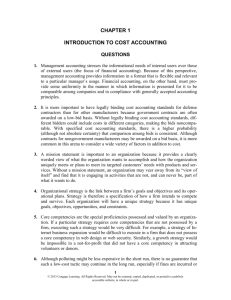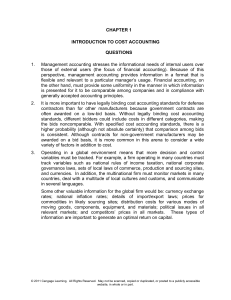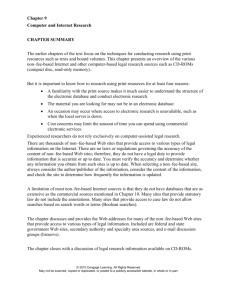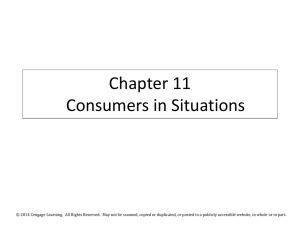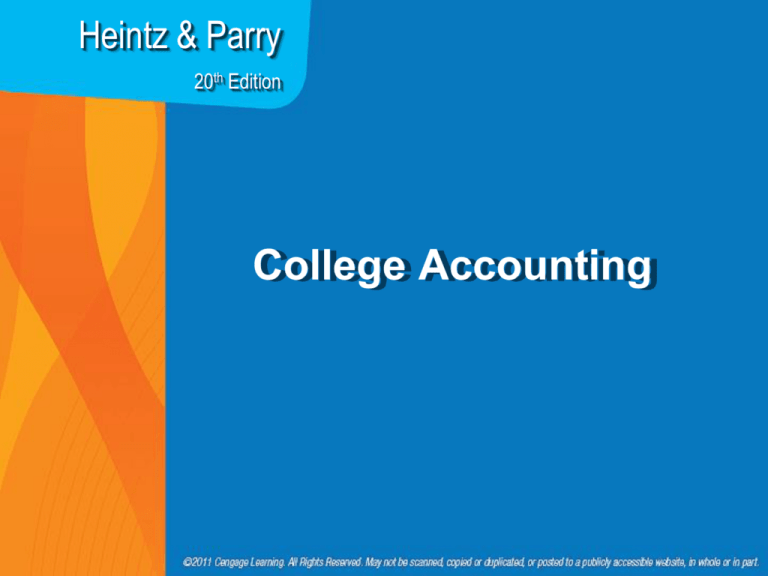
Heintz & Parry
20th Edition
College Accounting
Chapter
17
Accounting for Notes
and Interest
1
Describe a
promissory note.
PROMISSORY NOTE
• A written promise to pay a specific sum at
a definite future date
• Also called a “note”
• Often used when credit is extended for 60
days or more, or when large amounts of
money are involved
PROMISSORY NOTE
$ 2,500.00
PRINCIPAL
©2011 Cengage Learning. All Rights Reserved. May not be scanned, copied or duplicated, or posted to a publicly accessible website, in whole or in part.
PROMISSORY NOTE
$ 2,500.00
Date of
the note
June 9,
©2011 Cengage Learning. All Rights Reserved. May not be scanned, copied or duplicated, or posted to a publicly accessible website, in whole or in part.
20 - -
PROMISSORY NOTE
$ 2,500.00
Ninety Days
June 9,
AFTER DATE
I
20 - -
PROMISE TO PAY TO
©2011 Cengage Learning. All Rights Reserved. May not be scanned, copied or duplicated, or posted to a publicly accessible website, in whole or in part.
PROMISSORY NOTE
$ 2,500.00
Ninety Days
June 9,
AFTER DATE
THE ORDER OF Central Bank
I
20 - -
PROMISE TO PAY TO
PAYEE
©2011 Cengage Learning. All Rights Reserved. May not be scanned, copied or duplicated, or posted to a publicly accessible website, in whole or in part.
PROMISSORY NOTE
$ 2,500.00
Ninety Days
June 9,
AFTER DATE
I
20 - -
PROMISE TO PAY TO
THE ORDER OF Central Bank
Two Thousand Five Hundred and 00/100
PAYABLE AT Central Bank
WITH INTEREST AT 9% per Annum from Date
Notes may be
interest bearing or
non-interest bearing.
©2011 Cengage Learning. All Rights Reserved. May not be scanned, copied or duplicated, or posted to a publicly accessible website, in whole or in part.
PROMISSORY NOTE
$ 2,500.00
Ninety Days
June 9,
AFTER DATE
I
PROMISE TO PAY TO
THE ORDER OF Central Bank
Two Thousand Five Hundred and 00/100
PAYABLE AT Central Bank
WITH INTEREST AT 9% per Annum from Date
No. 2307 Due Sept. 7, 20--
20 - -
MATURITY
DATE
©2011 Cengage Learning. All Rights Reserved. May not be scanned, copied or duplicated, or posted to a publicly accessible website, in whole or in part.
PROMISSORY NOTE
$ 2,500.00
Ninety Days
June 9,
I
AFTER DATE
20 - -
PROMISE TO PAY TO
THE ORDER OF Central Bank
Two Thousand Five Hundred and 00/100
PAYABLE AT Central Bank
WITH INTEREST AT 9% per Annum from Date
No. 2307 Due Sept. 7, 20--
MAKER
OF NOTE
Sarah Morney
©2011 Cengage Learning. All Rights Reserved. May not be scanned, copied or duplicated, or posted to a publicly accessible website, in whole or in part.
2
Calculate interest on and
determine the due date of
promissory notes.
TERM OF THE NOTE
• The months or days from the date of issue
to the date of maturity
• Used to calculate TIME:
– The term of the note stated as a
fraction of a year
• Note: It is common to use 360 days as a
year
When the term of note is
expressed as months,
TIME is calculated in months.
TERM OF THE NOTE
• The months or days from the date of issue
to the date of maturity
• Used to calculate TIME:
– The term of the note stated as a
fraction of a year
• Note: It is common to use 360 days as a
year
When the term of the note is expressed
as days, the TIME is calculated using
the exact number of days.
COMPUTING THE DUE DATE
EXAMPLE: The note signed by Sarah Mornay
is dated June 9, 20-- and is due in 90 days.
Days in June
STEP #1
Start with the month
the note was issued.
30
COMPUTING THE DUE DATE
EXAMPLE: The note signed by Sarah Mornay
is dated June 9, 20-- and is due in 90 days.
Days in June
Deduct date of note (June 9)
Days remaining in June
30
9
21
Subtract the date the note was issued
(do not count the date of issuance).
COMPUTING THE DUE DATE
EXAMPLE: The note signed by Sarah Mornay
is dated June 9, 20-- and is due in 90 days.
Days in June
Deduct date of note (June 9)
Days remaining in June
Add: Days in July
Days in August
30
9
21
31
31
STEP #2
Add to the result of step #1 the number of
days in as many months as possible without
exceeding the time of the note.
COMPUTING THE DUE DATE
EXAMPLE: The note signed by Sarah Mornay
is dated June 9, 20-- and is due in 90 days.
Days in June
Deduct date of note (June 9)
Days remaining in June
Add: Days in July
Days in August
By the end of August,
83 days of the note have past.
30
9
21
31
31
COMPUTING THE DUE DATE
EXAMPLE: The note signed by Sarah Mornay
is dated June 9, 20-- and is due in 90 days.
Days in June
Deduct date of note (June 9)
Days remaining in June
Add: Days in July
Days in August
30
9
21
31
31
STEP #3
Subtract the result of step #2
from the time of the note (90 – 83).
COMPUTING THE DUE DATE
EXAMPLE: The note signed by Sarah Mornay
is dated June 9, 20-- and is due in 90 days.
Days in June
Deduct date of note (June 9)
Days remaining in June
Add: Days in July
Days in August
The result is the date of the
month the note is due.
30
9
21
31
31
COMPUTING THE DUE DATE
EXAMPLE: The note signed by Sarah Mornay
is dated June 9, 20-- and is due in 90 days.
Days in June
Deduct date of note (June 9)
Days remaining in June
Add: Days in July
Days in August
Maturity date, September 7
The 90th day (Sept. 7th) is
called the maturity date.
30
9
21
31
31
7
COMPUTING THE DUE DATE
EXAMPLE: The note signed by Sarah Mornay
is dated June 9, 20-- and is due in 90 days.
Days in June
Deduct date of note (June 9)
Days remaining in June
Add: Days in July
Days in August
Maturity date, September 7
Total time in days
30
9
21
31
31
7
90
CALCULATING INTEREST
EXAMPLE: The note signed by Sarah Mornay
has a principal of $2,500, an annual interest
rate of 9%, and is due in 90 days.
FORMULA:
PRINCIPAL RATE TIME
$2,500.00 9% 90/360
$56.25
interest
CALCULATING INTEREST
EXAMPLE: A $2,000, 8% note due in 3 months
FORMULA:
PRINCIPAL
RATE
8%
$2,000.00
$40
interest
TIME
3/12
3
Account for notes
receivable transactions and
accrued interest.
NOTES RECEIVABLE
TRANSACTIONS
• Seven types:
– Note received from a customer in
exchange for assets sold
– Note received from a customer to
extend time for payment of an account
– Note collected at maturity
– Note renewed at maturity
– Note discounted before maturity
– Note dishonored
– Collection of dishonored note
NOTE RECEIVED IN EXCHANGE FOR
ASSETS
EXAMPLE: On June 1, Linesch Hardware Co.
sells an industrial mower to Williams
Manufacturing for $8,500 in exchange for a
180-day, 9% note signed by Williams.
GENERAL JOURNAL
1
2
3
4
DATE
DESCRIPTION
20-June 1 Notes Receivable
PR DEBIT CREDIT
Sales
Received note for
merchandise sale
8,500
8,500
5
6
7
8
9
10
11
This is simply a sale in which
the buyer signs a note (a promise to pay).
Note that the seller will receive interest
as well as principal.
©2011 Cengage Learning. All Rights Reserved. May not be scanned, copied or duplicated, or posted to a publicly accessible website, in whole or in part.
GENERAL JOURNAL
1
2
3
4
5
DATE
DESCRIPTION
20-Nov. 28 Cash
PR DEBIT CREDIT
8,882.50
Notes Receivable
Interest Revenue
Received principal and
interest
6
7
8
9
10
11
Assume 180 days later, Williams
Manufacturing pays the maturity value
of the note (principal plus interest).
©2011 Cengage Learning. All Rights Reserved. May not be scanned, copied or duplicated, or posted to a publicly accessible website, in whole or in part.
8,500.00
382.50
NOTE RECEIVED TO EXTEND TIME
FOR PAYMENT
EXAMPLE: Accounts receivable customer,
Michael Putter, owes $2,000 to Linesch
Hardware Co. To settle this account, Putter
signs a 90-day, 10% note dated June 8.
Why would we want to
accept this note?
NOTE RECEIVED TO EXTEND TIME
FOR PAYMENT
EXAMPLE: Accounts receivable customer,
Michael Putter, owes $2,000 to Linesch
Hardware Co. To settle this account, Putter
signs a 90-day, 10% note dated June 8.
Two reasons to accept this note:
1. The note is a formal, written promise to
pay
– Can be converted to cash at a bank if
necessary
2. The note is likely to bear interest
GENERAL JOURNAL
1
2
3
4
DATE
DESCRIPTION
20-June 8 Notes Receivable
PR DEBIT CREDIT
2,000
Accts. Receivable/M. Putter
Received note to settle
account
5
6
7
8
9
10
11
Mr. Putter’s balance is removed
from Accounts Receivable and
placed into Notes Receivable.
©2011 Cengage Learning. All Rights Reserved. May not be scanned, copied or duplicated, or posted to a publicly accessible website, in whole or in part.
2,000
NOTE RECEIVED TO EXTEND TIME
FOR PAYMENT
EXAMPLE: What if accounts receivable
customer, Michael Putter, gives a check for
$250 and a note for $1,750 instead?
Let’s look at
the journal
entry!
GENERAL JOURNAL
1
2
3
4
5
DATE
DESCRIPTION
20-June 8 Cash
Notes Receivable
Accts. Receivable/M. Putter
Received cash and note
PR DEBIT CREDIT
250
1,750
to settle account
6
7
8
9
10
11
©2011 Cengage Learning. All Rights Reserved. May not be scanned, copied or duplicated, or posted to a publicly accessible website, in whole or in part.
2,000
NOTE COLLECTED AT MATURITY
• When a note receivable matures, it may
be collected:
– By the payee
– By the bank named in the note
– By a bank where it was left for
collection
NOTE COLLECTED AT MATURITY
EXAMPLE: On September 6 (the due date),
Putter pays the principal and interest on the
note.
Principal of note
Interest
$2,000
50
$2,000 × 10% × 90/360
NOTE COLLECTED AT MATURITY
EXAMPLE: On September 6 (the due date),
Putter pays the principal and interest on the
note.
Principal of note
Interest
$2,000
50
Maturity value
$2,050
GENERAL JOURNAL
1
2
3
4
5
DATE
DESCRIPTION
20-Sept. 6 Cash
PR DEBIT CREDIT
2,050
Notes Receivable
Interest Revenue
Received payment of note
with interest
6
7
8
9
10
11
©2011 Cengage Learning. All Rights Reserved. May not be scanned, copied or duplicated, or posted to a publicly accessible website, in whole or in part.
2,000
50
NOTE COLLECTED AT MATURITY
EXAMPLE: What if the note had been left at
Planet Bank for collection instead?
Planet Bank would collect the maturity
value from Putter, subtract out a service
charge, and deposit the remainder in
Linesch’s account.
GENERAL JOURNAL
1
2
3
4
5
DATE
DESCRIPTION
20-Sept. 6 Cash
Collection Expense
Notes Receivable
PR DEBIT CREDIT
2,040
10
Interest Revenue
6
Received payment of note
with interest less collection
7
fee
8
9
10
11
©2011 Cengage Learning. All Rights Reserved. May not be scanned, copied or duplicated, or posted to a publicly accessible website, in whole or in part.
2,000
50
NOTE RENEWED AT MATURITY
EXAMPLE: What if Mr. Putter had been able to
pay the interest due on the note and asked to
renew the note?
Linesch Hardware Co. would collect the
interest, and accept a new note to replace
the original note.
GENERAL JOURNAL
1
2
3
4
DATE
DESCRIPTION
20-Sept. 6 Cash
Notes Receivable (new note)
PR DEBIT CREDIT
50
2,000
Notes Receivable (old note)
Interest Revenue
5
Received new note plus
6
interest on old note
7
8
9
10
11
©2011 Cengage Learning. All Rights Reserved. May not be scanned, copied or duplicated, or posted to a publicly accessible website, in whole or in part.
2,000
50
NOTE RENEWED AT MATURITY
EXAMPLE: What if Mr. Putter had been able to
pay the interest due on the note, pay $500 on
the principal, and asked to renew the balance
of the note?
Linesch Hardware Co. would collect the
interest and partial payment, and accept a
new note to replace the original note.
GENERAL JOURNAL
1
2
3
4
DATE
DESCRIPTION
20-Sept. 6 Cash
Notes Receivable (new note)
550
1,500
Notes Receivable (old note)
Interest Revenue
5
Received new note plus
6
partial payment and interest
on old note
7
PR DEBIT CREDIT
8
9
10
11
©2011 Cengage Learning. All Rights Reserved. May not be scanned, copied or duplicated, or posted to a publicly accessible website, in whole or in part.
2,000
50
NOTE DISCOUNTED BEFORE
MATURITY
• If a business needs cash before the due
date of a note, it can endorse the note and
transfer it to a bank
– The bank charges an interest fee called
a “bank discount”
• For the time between the date of
discounting and the due date of the note
– The difference between the maturity
value and the bank discount is called
the “proceeds”
NOTE DISCOUNTED BEFORE
MATURITY
EXAMPLE: Assume the $2,000, 10%, 90-day
note from Putter dated June 8 is discounted
at the bank on July 8 at a rate of 12%.
Calculating
the discount and
proceeds is a fourstep process.
NOTE DISCOUNTED BEFORE
MATURITY
EXAMPLE: Assume the $2,000, 10%, 90-day
note from Putter dated June 8 is discounted
at the bank on July 8 at a rate of 12%.
Step #1 Compute the maturity value of the note.
Face
+
Interest
=
Maturity Value
$2,000
+
$50
=
$2,050
NOTE DISCOUNTED BEFORE
MATURITY
EXAMPLE: Assume the $2,000, 10%, 90-day
note from Putter dated June 8 is discounted at
the bank on July 8 at a rate of 12%.
Step #2 Compute the number of days in the
discount period—from the discount date to the
due date.
Days in July
Less: Discount date
31
8
The discount date is not
counted in the discount period.
NOTE DISCOUNTED BEFORE
MATURITY
EXAMPLE: Assume the $2,000, 10%, 90-day
note from Putter dated June 8 is discounted at
the bank on July 8 at a rate of 12%.
Step #2 Compute the number of days in the
discount period—from the discount date to
the due date.
Days in July
Less: Discount date
Remaining days in July
Plus days in August
Plus due date (Sept.)
Days in discount period
31
8
23
31
6
60
NOTE DISCOUNTED BEFORE
MATURITY
EXAMPLE: Assume the $2,000, 10%, 90-day
note from Putter dated June 8 is discounted at
the bank on July 8 at a rate of 12%.
Step #3 Compute the discount amount.
Maturity Discount Discount Discount
=
Value
Period
Amount
Rate
$2,050
12%
60/360
=
$41
NOTE DISCOUNTED BEFORE
MATURITY
EXAMPLE: Assume the $2,000, 10%, 90-day
note from Putter dated June 8 is discounted at
the bank on July 8 at a rate of 12%.
Step #4 Compute the proceeds.
Maturity
Discount
– Amount
Value
$2,050
–
$41
= Proceeds
=
$2,009
Let’s journalize the
discounting of this note.
GENERAL JOURNAL
1
2
3
4
DATE
DESCRIPTION
20-July 8 Cash
PR DEBIT CREDIT
2,009
Notes Receivable
Interest Revenue
Discounted note receivable
5
6
7
What if the proceeds are less than
the face value of the note?
8
9
10
11
©2011 Cengage Learning. All Rights Reserved. May not be scanned, copied or duplicated, or posted to a publicly accessible website, in whole or in part.
2,000
9
GENERAL JOURNAL
1
2
3
4
DATE
DESCRIPTION
20-July 8 Cash
PR DEBIT CREDIT
Interest Expense
Notes Receivable
1,992
8
Discounted note receivable
5
6
7
The difference represents
interest expense.
8
9
10
11
©2011 Cengage Learning. All Rights Reserved. May not be scanned, copied or duplicated, or posted to a publicly accessible website, in whole or in part.
2,000
NOTE DISHONORED
• The maker of the note does not pay or
renew it at maturity
• The maker is still liable
• The note loses its legal status
• The payee transfers the amount due from
Notes Receivable to Accounts Receivable
NOTE DISHONORED
EXAMPLE: Putter dishonors the $2,000, 10%,
90-day note.
Interest, although it has not
been paid by the maker,
is recognized as earned
by the payee.
GENERAL JOURNAL
1
2
3
4
DATE
DESCRIPTION
20-Sept. 6 Accounts Receivable/Putter
Notes Receivable
PR DEBIT CREDIT
2,050
Interest Revenue
Note receivable dishonored
5
6
7
8
The entire maturity value is
debited to Accounts Receivable.
9
10
11
©2011 Cengage Learning. All Rights Reserved. May not be scanned, copied or duplicated, or posted to a publicly accessible website, in whole or in part.
2,000
50
NOTE DISHONORED
EXAMPLE: If Putter’s note had been
discounted at the bank and then was
dishonored by the maker, the bank will
require the PAYEE to pay the principal,
interest, and bank fees.
The payee then attempts to
recover the maturity value
PLUS the bank fee
from the maker.
GENERAL JOURNAL
1
2
3
4
DATE
DESCRIPTION
20-Sept. 6 Accounts Receivable/Putter
PR DEBIT CREDIT
2,060
Cash
Paid bank for dishonored
note, including a $10 bank fee.
5
6
7
8
9
10
11
©2011 Cengage Learning. All Rights Reserved. May not be scanned, copied or duplicated, or posted to a publicly accessible website, in whole or in part.
2,060
COLLECTION OF A DISHONORED
NOTE
EXAMPLE: On October 16, the payee collects
from Putter after the note had been
discounted and dishonored.
The maker pays the maturity
value, bank fee, and additional
interest at 10% for the period since
dishonoring the note.
GENERAL JOURNAL
1
2
3
4
5
DATE
DESCRIPTION
20-Oct. 16 Cash
PR DEBIT CREDIT
2,082.89
Principal + Interest + Bank Fee
$2,000 + $50 + $10 = $2,060
6
$2,060 × 10% ×40/360 = $22.89
7
$2,060 + $22.89 = $2,082.89
8
9
10
11
©2011 Cengage Learning. All Rights Reserved. May not be scanned, copied or duplicated, or posted to a publicly accessible website, in whole or in part.
GENERAL JOURNAL
1
2
3
4
5
DATE
DESCRIPTION
20-Oct. 16 Cash
PR DEBIT CREDIT
2,082.89
Accounts Receivable
Interest Revenue
Collected dishonored note
with interest
6
7
8
9
10
11
©2011 Cengage Learning. All Rights Reserved. May not be scanned, copied or duplicated, or posted to a publicly accessible website, in whole or in part.
2,060.00
22.89
NOTES RECEIVABLE REGISTER
Date
Rcvd.
Maker
20--
Interest
Time Due Date Amount Rate Amount
Apr.
4 L. Peters
21 J. Slaw
May 2 S. Alpart
19 L. Shein
60 days June 3
60 days June 21
30 days June 1
90 days Aug. 17
400.00
600.00
700.00
800.00
8%
9%
9%
9%
5.33
9.00
5.25
18.00
June 20 J. Slaw
60 days Aug. 19
500.00 9%
7.50
When a business has many notes,
it may keep a notes receivable
register.
©2011 Cengage Learning. All Rights Reserved. May not be scanned, copied or duplicated, or posted to a publicly accessible website, in whole or in part.
NOTES RECEIVABLE REGISTER
Interest
Rate Amount
8%
5.33
9%
9.00
9%
5.25
9%
18.00
9%
7.50
Discounted
Bank
Date
Date
Collected
Remarks
June 3
June 20 Renewal for $500
June 1 Sent for collection 5/30
Renewal of 4/21 note
©2011 Cengage Learning. All Rights Reserved. May not be scanned, copied or duplicated, or posted to a publicly accessible website, in whole or in part.
ACCRUED INTEREST RECEIVABLE
• Revenue should be recognized when it is
earned
– Not always practical
• Interest is earned day by day
– It is common for interest to be
recognized when the note is due
• If the note is received and due within a
single accounting period
– If the note is received in one period and
due in the next, accrued interest must
be recorded at the end of the period
ACCRUED INTEREST RECEIVABLE
EXAMPLE: The fiscal year ends on June 30.
Two notes from the notes receivable register
remain outstanding. Accrued interest on these
notes must be calculated and recognized.
Principal
$800.00
Date of
Issue
May 19
Rate of
Interest
9%
Days from
Issue Date
to June 30
42
$800.00 × 9% × 42/360
Accrued
Interest
June 30
$8.40
ACCRUED INTEREST RECEIVABLE
EXAMPLE: The fiscal year ends on June 30.
Two notes from the notes receivable register
remain outstanding. Accrued interest on these
notes must be calculated and recognized.
Principal
$800.00
$500.00
Date of
Issue
May 19
June 20
Rate of
Interest
9%
9%
Days from
Issue Date
to June 30
42
10
Accrued
Interest
June 30
$8.40
1.25
$9.65
GENERAL JOURNAL
1
2
3
4
DATE
DESCRIPTION
20-June 30 Accrued Interest Receivable
PR DEBIT CREDIT
Interest Revenue
Interest accrued on notes
receivable
9.65
9.65
5
6
7
8
9
10
11
©2011 Cengage Learning. All Rights Reserved. May not be scanned, copied or duplicated, or posted to a publicly accessible website, in whole or in part.
4
Account for notes
payable transactions
and accrued interest.
NOTES PAYABLE TRANSACTIONS
• Five types:
– Note issued to a supplier in exchange
for assets purchased
– Note issued to a supplier to extend time
for payment of an account
– Note issued as security for cash loan
– Note paid at maturity
– Note renewed at maturity
NOTE ISSUED IN EXCHANGE FOR
ASSETS
EXAMPLE: On June 1, Linesch Hardware Co.
purchases a truckload of trees and shrubs
from Evergreen Enterprises and signs a
$4,000, 90-day, 9% note in exchange.
The maker would record
this as a note payable.
GENERAL JOURNAL
1
2
3
4
DATE
DESCRIPTION
20-June 1 Purchases
PR DEBIT CREDIT
4,000
Notes Payable
Issued note for inventory
purchase
5
6
7
8
9
10
11
©2011 Cengage Learning. All Rights Reserved. May not be scanned, copied or duplicated, or posted to a publicly accessible website, in whole or in part.
4,000
NOTE ISSUED TO EXTEND TIME FOR
PAYMENT
EXAMPLE: $700 is owed to Bella & Co. on
June 11. Bella & Co. agrees to accept a $700,
90-day, 10% note dated June 11.
GENERAL JOURNAL
1
2
3
DATE
DESCRIPTION
PR DEBIT CREDIT
20-June 11 Accounts Payable/Bella & Co.
700
Notes Payable
Issued note to settle account
4
5
6
7
8
The balance owed to Bella & Co.
is removed from Accounts Payable and
placed into Notes Payable.
9
10
11
©2011 Cengage Learning. All Rights Reserved. May not be scanned, copied or duplicated, or posted to a publicly accessible website, in whole or in part.
700
NOTE ISSUED TO EXTEND TIME FOR
PAYMENT
EXAMPLE: A partial payment of $200 is made
to Bella & Co. on June 11. A note is issued to
Bella & Co. for the remaining $500.
Let’s look at
the journal
entry!
GENERAL JOURNAL
1
2
3
4
5
DATE
DESCRIPTION
PR DEBIT CREDIT
20-June 11 Accounts Payable/Bella & Co.
700
Cash
Notes Payable
Made partial payment and
issued note to settle account
6
7
8
9
10
11
©2011 Cengage Learning. All Rights Reserved. May not be scanned, copied or duplicated, or posted to a publicly accessible website, in whole or in part.
200
500
NOTE ISSUED AS SECURITY FOR
CASH LOAN
•
•
•
Two types:
Interest-bearing notes
– The face value of the note is received in
cash
– The maker pays face value plus interest at
maturity
Non-interest-bearing notes
– Interest is deducted in advance, called
“discounting”
– Face value minus interest is received in
cash
– The maker pays face value at maturity
INTEREST-BEARING NOTES
EXAMPLE: Borrowed $6,000 on June 16 from
Planet Bank on a 60-day, 10.5% note.
Let’s look at
the journal
entry!
GENERAL JOURNAL
1
2
3
DATE
DESCRIPTION
20-June 16 Cash
PR DEBIT CREDIT
6,000
Notes Payable
Issued note for bank loan
4
5
6
7
8
9
10
11
©2011 Cengage Learning. All Rights Reserved. May not be scanned, copied or duplicated, or posted to a publicly accessible website, in whole or in part.
6,000
NON-INTEREST-BEARING NOTES
EXAMPLE: A non-interest-bearing, 60-day note
was issued for $6,000 on June 16. The bank
discounts at the rate of 10.5%.
The maker will not receive
the whole $6,000.
(10.5% $6,000 60/360 = $105 discount;
$6,000 – $105 = $5,895)
GENERAL JOURNAL
1
2
3
4
5
6
DATE
DESCRIPTION
20-June 16 Cash
PR DEBIT CREDIT
5,895
The maker receives the
proceeds but promised to
pay the maturity value ($6,000).
7
8
9
10
11
©2011 Cengage Learning. All Rights Reserved. May not be scanned, copied or duplicated, or posted to a publicly accessible website, in whole or in part.
GENERAL JOURNAL
1
2
3
4
DATE
DESCRIPTION
20-June 16 Cash
Discount on Notes Payable
Notes Payable
Issued note for bank loan
PR DEBIT CREDIT
5,895
105
5
6
7
8
9
10
11
©2011 Cengage Learning. All Rights Reserved. May not be scanned, copied or duplicated, or posted to a publicly accessible website, in whole or in part.
6,000
Maker of the Note Balance Sheet
June 30, 20-Assets
Current assets
Liabilities
Current liabilities
Notes payable
Less: Discount on notes payable
$6,000
105
The balance sheet shows the
discount on notes payable
as a reduction from the
notes payable account.
©2011 Cengage Learning. All Rights Reserved. May not be scanned, copied or duplicated, or posted to a publicly accessible website, in whole or in part.
$5,895
STATED vs. EFFECTIVE INTEREST
RATE
INTEREST-BEARING
NOTE
NON-INTERESTBEARING NOTE
$105/$6,000 = 1.75%
Interest rate for 60 days
STATED vs. EFFECTIVE INTEREST
RATE
INTEREST-BEARING
NOTE
$105/$6,000 = 1.75%
6
10.5%
Effective rate
NON-INTERESTBEARING NOTE
STATED vs. EFFECTIVE INTEREST
RATE
INTEREST-BEARING
NOTE
NON-INTERESTBEARING NOTE
$105/$6,000 = 1.75%
6
10.5%
Interest-bearing notes:
Effective rate = Stated rate
STATED vs. EFFECTIVE INTEREST
RATE
INTEREST-BEARING
NOTE
NON-INTERESTBEARING NOTE
$105/$6,000 = 1.75% $105/$5,895 = 1.781%
6
6
10.686%
10.5%
Non-interest-bearing notes:
Effective rate Stated rate
NOTE PAID AT MATURITY
EXAMPLE: The interest-bearing note is paid
at maturity.
$6,000 10.5% 60/360 = $105 interest
$6,000 + $105 = $6,105 paid
GENERAL JOURNAL
1
2
3
4
5
DATE
DESCRIPTION
20-Aug. 15 Notes Payable
Interest Expense
Cash
Paid note with interest at
PR DEBIT CREDIT
6,000
105
maturity
6
7
8
9
10
11
©2011 Cengage Learning. All Rights Reserved. May not be scanned, copied or duplicated, or posted to a publicly accessible website, in whole or in part.
6,105
NOTE PAID AT MATURITY
Now let’s look at the non-interest-bearing
note at maturity.
A $6,000 maturity value is paid to the
payee. Discount on Notes Payable
becomes Interest Expense.
GENERAL JOURNAL
1
2
3
DATE
DESCRIPTION
20-Aug. 15 Notes Payable
4
Interest Expense
Cash
Discount on Notes Payable
5
Paid note at maturity
PR DEBIT CREDIT
6,000
105
6
7
8
9
10
11
©2011 Cengage Learning. All Rights Reserved. May not be scanned, copied or duplicated, or posted to a publicly accessible website, in whole or in part.
6,000
105
NOTE RENEWED AT MATURITY
EXAMPLE: The maker pays only $1,000 plus
the $105 interest on the $6,000 note and
signs a new $5,000, 60-day, 10.5% note.
The old note is removed,
interest expense of $105 is recognized,
cash is reduced, and a new note
is recorded.
GENERAL JOURNAL
1
2
3
DATE
DESCRIPTION
20-Aug. 15 Notes Payable (old note)
4
Interest Expense
Cash
Notes Payable (new note)
5
Paid interest and part of
6
principal on old note and
issued new note
7
PR DEBIT CREDIT
6,000
105
8
9
10
11
©2011 Cengage Learning. All Rights Reserved. May not be scanned, copied or duplicated, or posted to a publicly accessible website, in whole or in part.
1,105
5,000
NOTES PAYABLE REGISTER
Date
Issued
20--
Maker
Apr. 14 L. Knoop
May 13 Apex Bank
June 2 S. Bront
Interest
Time Due Date Amount Rate Amount
60 days June 13 2,000.00 9%
90 days Aug. 11 8,000.00 10%
30 days July 2 1,500.00 11%
Multiple notes are recorded
in a notes payable register.
©2011 Cengage Learning. All Rights Reserved. May not be scanned, copied or duplicated, or posted to a publicly accessible website, in whole or in part.
30.00
200.00
13.75
NOTES PAYABLE REGISTER
Amount
2,000.00
Date
Interest
Remarks
Paid
Rate
Amount
9%
30.00 June 13 Settled 2/14 invoice
8,000.00 10%
1,500.00 11%
200.00
13.75
Settled 4/2 invoice
©2011 Cengage Learning. All Rights Reserved. May not be scanned, copied or duplicated, or posted to a publicly accessible website, in whole or in part.
ACCRUED INTEREST PAYABLE
EXAMPLE: Issued a $900, 60-day, 10% note
on May 31. June 30 is the company’s fiscal
year end.
An adjusting entry is needed
on June 30 to record the interest
accrued on the note from
May 31 to June 30.
GENERAL JOURNAL
1
2
3
4
DATE
DESCRIPTION
20-June 30 Interest Expense
PR DEBIT CREDIT
7.50
Accrued Interest Payable
Interest accrued on note
payable
5
6
7
8
9
10
11
©2011 Cengage Learning. All Rights Reserved. May not be scanned, copied or duplicated, or posted to a publicly accessible website, in whole or in part.
7.50
ACCRUED INTEREST PAYABLE
EXAMPLE: If instead it was a $900, 60-day,
non-interest-bearing note that was
discounted at the bank at 10%...
An adjusting entry is needed
on June 30 to move the interest
for the period (May 31 to June 30)
from Discount on Notes Payable
to Interest Expense.
GENERAL JOURNAL
1
2
3
4
DATE
DESCRIPTION
20-May 31 Cash
PR DEBIT CREDIT
Discount on Notes Payable
885
15
Notes Payable
Issued note for bank loan
5
6
7
8
Journal entry to record
the note’s issuance
9
10
11
©2011 Cengage Learning. All Rights Reserved. May not be scanned, copied or duplicated, or posted to a publicly accessible website, in whole or in part.
900
GENERAL JOURNAL
1
2
3
4
DATE
DESCRIPTION
20-May 31 Cash
Discount on Notes Payable
PR DEBIT CREDIT
885
15
Notes Payable
Issued note for bank loan
900
5
6
7
June 30 Interest Expense
Discount on Notes Payable
8
Interest accrued on note
9
payable
10
11
7.50
©2011 Cengage Learning. All Rights Reserved. May not be scanned, copied or duplicated, or posted to a publicly accessible website, in whole or in part.
7.50



